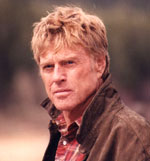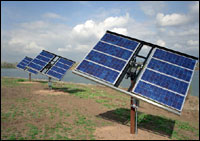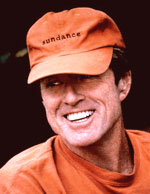He played the Sundance Kid, the sharpshooter sidekick to Paul Newman’s Butch Cassidy in the 1969 classic; he built the Sundance Village in the Wasatch Mountains of Utah; he founded the Sundance Institute for independent film and theater production and established the Sundance Film Festival. But all the while, Robert Redford has been doing an altogether more literal kind of sun dance: preaching the clean-energy gospel at the grassroots, in the op-ed pages of newspapers, on the big screen, and inside the Beltway.

Solar is not a new fascination for the actor and director. As far back as 1975, Redford began working on short films and documentaries promoting solar power. More recently, he has been a major supporter of Vote Solar, the San Francisco organization responsible for securing $100 million in city bonds for investment in renewable energy and efficiency measures on municipal buildings — a model that is now being adopted by cities and states nationwide.
And today — as in literally today, Nov. 13, 2003 — Redford is officiating at the opening ceremony for what the U.S. Green Building Council has called “the greenest building in the nation”: the Santa Monica office of the Natural Resources Defense Council, which will get 100 percent of its energy from solar and wind power. The building will be named for Redford, who is not only a trustee and a founding member of NRDC, but also a funder of the $8.3 million dollar project.
Redford’s environmental activism has gone beyond renewable-energy advocacy, from lobbying for the Clean Air Act and Clean Water Act in the 1970s to holding international conferences on global warming in the ’80s to campaigning for pro-environment Democratic politicians in the ’90s (which he says he also plans to do in the 2004 elections).
Still, even the great horse whisperer has a few environmental skeletons in his closet. A onetime racecar driver and former owner of various all-terrain vehicles (not to mention a major player in notoriously eco-insensitive Hollywood), Redford freely admits to having been “extremely hypocritical” in the past. After reading the following Grist interview, though, even the purest of environmentalists will have to admit that few celebrities — or politicians and activists, for that matter — have shown as much dogged dedication to the environmental movement as Robert Redford.
Robert Redford: Hullo there, it’s Bob. Please don’t call me Mr. Redford. It’s Bob, or just Redford. I’m not a “mister,” never have been.
Okay, Bob. Your involvement with the environmental movement goes way back and covers an amazing array of issues. What are you focusing on these days? What’s your biggest concern?
The Bush administration has advocated the most destructive policies I’ve seen in the more than three decades I’ve been working on these matters. From the moment Bush stepped into office, not only has he been leading a vast and disciplined campaign to cripple environmental protections and enforcement across the board, he’s been manufacturing more immediate crises — war, for one — that have kept the American public distracted and completely in the dark. And what makes our Republican leadership, both in the White House and Congress, seem all the more stupendously ignorant is that they’re implementing these backward policies at a time when they could be pushing forward a new era of solutions — tremendous technological advancements related to things like energy efficiency, renewables, sustainable building, and agriculture that are so incredibly exciting. It’s as though they can’t even see the historic opportunity they’re passing up.
Wow, you clearly feel strongly about this! What exactly are you doing about it?
Well, I’m doing some work to help fundraise for the 2004 elections and level the remarkable imbalance of campaign financing the Democrats are up against. And I’m working, as I have been for years, with over a half-dozen organizations, local and national, mostly focused on land protection and energy issues. Energy is my biggest concern right now, mostly because there are so many great solutions in efficiency and renewable technology that need to be pushed.
So with the NRDC, among other things, I continue to work on advocating for the kind of energy bill we need and I try to do things with Vote Solar, the organization that convinced the city of San Francisco to invest $100 million on solar installations on public buildings — schools, buildings, jails, even sewage treatment plants — using government bonds that pay back over long-term periods. It’s already spread to eight other cities across the nation. They just did a conference educating mayors nationwide how to adopt solar in their cities in an economically manageable way. This project touches a personal nerve that goes way, way back.

More than a moment in the sun.
Photo: NREL.
A personal nerve?
I did a lot of projects advocating solar energy in the early to mid-’70s that were premature for a lot of reasons. One, because there wasn’t the awareness that there is now about the practical promise of solar. The petroleum industry had an easy time shooting it down in the ’70s because solar energy was still classified as woo-woo. They attacked solar advocates as being, you know, in new-age la-la land, in outer space.
Well, technically speaking, solar was in outer space at that time, right? Photovoltaics were being used almost exclusively on satellites in the ’70s. But the woo-woo association didn’t deter you from promoting it as an oil alternative?
No, it was soon after the Arab oil embargo and I was pretty convinced that we needed to come up with alternatives. I tried to use popular media to get the word out to the mainstream. I made a film on solar with Saul Bass in 1975, an eight-minute short called The Solar Film that took me two years to develop. It was a sort of unprecedented thing at the time because I was about to release All the President’s Men and I convinced the heads of the studio to attach The Solar Film to the release schedule for the feature as sort of an opening public service announcement. It probably wouldn’t be possible now considering the kinds of controls over the media industry, but back then it was pretty successful — won a few awards and things like that.
It seems like today would be a good time to re-release it.
I’m thinking about it!
In general, given all the current energy concerns, don’t you think now is the ideal time to revive this kind of media- and entertainment-based activism?
Absolutely, but we’re in a different time now than the ’70s. We have less innocence. We have less hope. We have less public mechanisms than we had then. There is more dominance by the powers that be. The technology has changed things; the medium has changed more toward the youth market, more in your face. More expressionistic versus impressionistic. It’s not a time for subtlety. And so therefore it has to be kind of in your face and loud and commercial. I’m not sure a little eight-minute animation would be appropriate in this media climate. People are dealing with such a flurry of images and racing through 500 channels and the Internet, so you have to change your approach; you have to exaggerate in order to get people to see, to get the attention, in order to move through the incredible paralytic apathy in the American mainstream.

What about Bob?
Apathy — can you elaborate?
Yeah, it’s like people skim past all news about the ozone hole and the latest mysterious fish die-off and the wetlands being drained and junked by developers and Glacier National Park in Montana that will have no glaciers within 25 years, and they skim past the fact that the levels and flow of the Colorado River will be 20 percent lower in the next 20 years — in our lifetimes! My God! The Colorado River drying up in our lifetimes! — or the fact that half the world’s species are facing extinction. The problem is definitely that people aren’t paying attention, that apathy is our biggest enemy.
So how do we get their attention?
I think the way is to tell the story, using modern-day scenarios and modern-day devices.
Like an Erin Brockovich kind of story?
Yeah, well, movies are a good way to touch a chord. The story has to be told in a popular culture framework. You have to have a human-interest element. You have to weave in characters and narrative, you have to touch a nerve, but the larger goal is activism and making change. That’s what I was trying to do with A River Runs Through It, sort of addressing this family that’s held together by this river and showing fly-fishing as a sort of soul-nourishing art. Then we got people thinking about the connection between human beings and the natural environment. We used the fundraising plan to raise money for Trout Unlimited and the American Rivers association and local Montana-based groups working to restore the Big Blackfoot River, which has become highly polluted from mining runoff.
Then there was The Milagro Beanfield War. I made that film about taking these people’s water — their inheritance over 400 years versus the big development company that wants to build golf courses — [about] the power of the bottom-up collective versus the top-down powers that be, and the whole story that surrounded a limited resource. We used that movie to help NGOs address development issues.
In the ’70s, you did different kinds of films, films that created or intensified distrust of the government among Americans — All the President’s Men, Three Days of the Condor, and the like. Those films seemed more deliberately activist. Why have you stopped making that kind of movie?
I think there are several ways to do it. It has a lot to do with cultural timing. When Watergate broke out, I felt a tremendous responsibility to the First Amendment and the issue of investigative journalism. I felt extremely obligated to preserve that ethic. And we’re back there again now. We’re losing very valuable constitutional rights.
Can you tell a story like that now? Do you think we need to tell those stories again? I’m imagining a sort of eco-Parallax View about how the Bush administration opened up all this public land to industrial exploits without the public knowing, and the $44 million the Bush administration received in campaign contributions from industry.
Oh, absolutely. It’s dizzying how many stories there are like that to be told right now. I am planning a film right now that I don’t want to talk too much about because I get nervous — a sequel to The Candidate. But again, the entertainment industry is very different than it was in the ’70s. And the political environment is moving so fast that one minute something is a big story and the next minute it’s passe. Outlets like FOX News have essentially pulled the entire media landscape to the right, telling these incredibly skewed stories so fast and so furiously. There has to be an equal acceleration on the other side to get the real story told about how the American people are being affected by the Bush administration’s corrupt policies, but it’s almost as if we don’t have time to get the stories out.
So given the Hollywood timetable — I mean, if it takes a year and a half at least to produce a film — wouldn’t it be difficult to turn around a mainstream film in time to tell the real story?
Unless it’s a quickie for television, but television these days is generally dominated by a conservative slant. There’s only one point of view being presented. It all boils down to that: who the players are and what the points of view are and what the stories going to be told are. That’s the battleground for the future.
Ugh. This all sounds very grim.
Well, no. We’re up against incredible odds, but that’s where you and I come in — to tell those stories as fast and furiously as we can, in magazines, movies, chat rooms, op-eds, wherever. My general feeling is actually positive. We have an obligation to focus on the positive. I find that there is hope and it’s the right kind of hope because it’s coming from the bottom up. It’s happening in Vote Solar. It’s happening in the “What Would Jesus Drive?” campaign, where all these local reverends are educating their communities about energy-efficient cars. It’s happening in the work of the NRDC, and we have to tell the stories of hope and solutions and not be daunted by the onslaught of stories from the right.
I’d love to tell the story, for instance, of Paul Wellstone’s campaign, when he worked against the tide of an incredible imbalance of campaign finance and he went door to door to get people’s support. He couldn’t rely on big advertising, so he just hit the road. And he won because he got to the people in such a direct way. And that was possible even in the theater of modern politics. Those are the kind of positive stories we have to focus on.
The Bush administration has a genius for storytelling. They couch all their policies in these rosy, patriotic terms like the Healthy Forests initiative and the Clear Skies initiative and so forth.
It’s insidious. I mean, listen to that rhetoric. It’s jingling with jingoism. It’s so ugly. So painfully ugly. And the only way they would even try to do that is that they know that they have apathy on their side. They like to wrap themselves in the American flag and yet they’re totally chipping away at what it stands for. This administration has learned the power of staying on message and keeping it simple. They are very, very shrewd in couching it in patriotism. Nearly every statement that comes from this administration includes the phrase “the American people,” which in their case is another way of saying “industrial interests.” Every time I hear that phrase “the American people,” I just substitute “industrial interests.”
If Dick Cheney were a plant, what kind of plant would he be?
A cactus. But one that holds oil, not water.
You’ve held large environmental conferences at Sundance and submitted reports from these conferences to the Reagan and Bush administrations. Can you tell us a little about that?
I’ve held a number of global warming conferences at Sundance. The first aimed to get environmentalists and developers together in one room to review all these proposed projects — who wanted to open up what — ANWR, Escalante, whatever — and who wanted to protect it. We got both sides to agree: If you let us explore here we’ll stay out of that. We sent it to the Reagan administration and they shelved it.
Then we did it again — a conference called “Greenhouse Glasnost” that came out of a trip I made to the Soviet Union in 1987, where I was asked to visit the Soviet Academy of Sciences and they were talking about global warming and I said, “This is so huge but no one knows about it! Would you please come to the United States and talk to us about it!” My business affairs guy tried to pull my shirt off to get me to sit down, said, “Jesus, Redford, are you out of your fucking mind? You can’t afford to bring these guys over!” I was inviting the entire Soviet academy to come to Sundance, and he’s like, “You’re out of your fucking mind!” And I’m like, “Yeah, I’m out of my fucking mind,” because I just get really — I mean I just fly off on this stuff.
So we did it. We had the head of the Soviet space program and all the top Soviet scientists. It took 18 months to pull it off and we had it at Sundance in 1988 and it was called Greenhouse Glasnost. And it was the top scientific authorities of both continents who came together and jointly agreed that this was a serious issue and came up with specifics about what could be done and should be done and the joint resolution was signed and sent to Gorbachev and the Bush Sr. administration, and again it was shelved.
Ouch. You must have felt pretty burned.
To put it mildly.
How do you compare the different administrations — Nixon versus Regan versus Bush I and II — in terms of their impact on the environment?
Well, Nixon had no clue. Reagan was very effective at pushing his pro-industry mandate because he relied on personality and charm and people liked him. Bush I seemed like the president of the Sierra Club compared to his son. This administration is a whole different beast: They’ve taken even the opportunity for public interests to respond out of the equation. Even Reagan and Bush I engaged in debate and conversation with environmental groups. This administration has completely sealed itself off.
The moment Bush got into office, they started moving like a panzer division, unraveling all the laws — logging regulations, pollution regulations for air and water, critical habitat, national monument protections, everything — everything is being rolled back, and probably most concerning is the obliteration of laws that allow for environmental review and public comment.
Didn’t you and [Interior Secretary] Gale Norton have a famous letter exchange last year in which she asked you to release a condor in public? And you wrote back to her and declined, saying, “I intend to use what time I have to do what I can to focus on the devastating environmental repercussions of the … decisions you are now making in your current capacity at the Interior Department.” Whoa!
Oh Jesus, do you remember that? Was that a joke or what? I mean, when I looked at that letter, I said, “You’ve got to be kidding.” First of all, it was so obvious they were looking for a photo op. She worked against the very act that allowed for the preservation of the condor! Second of all, I’d released a condor in captivity as part of the wildlife movement in California 12 years earlier. I was like, Hello? I’ve already released a condor, thanks! Twelve years ago! And you’re just coming around? And meanwhile you shred the rest of the country with mining and gas drilling and timber stuff and you’re going to release a condor and you think that’s going to make up for what you are doing?
It’s amazing to me that so many people in the Bush administration like Cheney and Norton were born and raised in the West, like you. Why doesn’t coming from that environment produce the desire to preserve it?
Well, part of it is the old “manifest destiny” still at play in the West: What we can take, we deserve. Look, there are Westerners and then there are Westerners. There was Morris Udall — he was a Westerner. There are many examples of Westerners who are good guys. I happen to think that John McCain is a good guy.
Tell us a little about your upbringing in the West and your formative years as an environmentalist.
I grew up in a non-privileged environment in southern California that was constricted by the war and sacrifice. I had family members who died in the war. I grew up in an ethnic neighborhood that was mostly Mexican and working class. I gained a respect for the environment because for me it was a way out. When I was a kid growing up, going into the desert, the Sierras, going into the ocean, going to swim and surf were these extraordinary resources — if I could just get to them. We were so confined by these parameters of war and the economics and the lack of privilege, so getting into the natural environment was this incredible joy. This incredible liftoff.
And then after the war, suddenly [there was this] acceleration unknown to man, [the wilderness] being wiped out in favor of development — freeways and concrete — I watched it all happen. It happened in my lifetime. So I go way beyond George Bush. I mean, my feeling about the environment goes back to being a kid and watching it be destroyed. So I took my family to Utah. A state with some of the most incredible natural assets in the world and the attitude of the leadership is: Wipe it out! So for me it’s this saga; it’s more than politics, it’s a way of life.
What’s your lifestyle like now? Do you have a worm bin?
Say what? Do I have a warm bed? What are you implying?

Something new under the Sundance.
Photo: Tena Parker Liddiard.
No, a worm bin. It’s that bucket of worms you feed to compost to help with decomposition. I’m asking if your lifestyle is eco-friendly.
Oh! Ha! Boy, I was really off-track with that one. Yeah, we do, in Utah. Most of the time I’m on a horse in the summertime and skis in the winter. And yeah, we do have compost. Sundance itself is trying to be a model community with art and nature coming together. There’s 5,000 acres; I’ve preserved 2,000 of it. We’ve got vegetable gardens and solar panels and all that. My home is passive solar and through the years I’ve adapted more and more energy-saving systems with it, from recycling to natural energy to glassblowing. Part of our art-shack program at Sundance Village has glass blowing and we do it from all the recycled bottles from the two restaurants. And so our plates and glasses are all made on the premises and recycled.
Yeah, but don’t you have any vices?
Well, I’m extremely hypocritical. I mean, I used to race cars when I was a kid, so it’s very hard for me to let go of the idea of a racing vehicle in my life. And I did have SUVs but I gave it up. I came to realize the disadvantage of them. I said, “Do I need an SUV in Los Angeles to drive around in traffic?” No; that to me is tremendously wasteful. And you might as well get with the program. But if you’re in a wilderness area — which I’m on the edge of in Utah — I would have a justification for using the SUV.
But for me, those days have pretty much ended and now I really do spend pretty much of my time on horseback. And I’m very happy because of it. I smell and see and feel things I never would have dreamed to feel if I were swishing through on a car. So that is not a loss for me; it’s actually a wonderful gain.
In the grand scheme of things, who are you most concerned about — the politicians, the media, the average Joes who can’t look past their SUVs? Which part of the equation are you most worried about?
It’s a bit of a domino thing. The overwhelming picture is that we simply don’t have any high-level moral leadership. It’s been on the decline for many, many years. And as the decline has occurred, the American people’s interest has also declined, so now we have voter turnout worse than it’s ever been in history, and each election it gets worse and worse. They’re moving into apathy. They don’t give a shit. And it’s a negative feedback loop: The less attention they pay, the more advantage for mediocre leadership to gain a foothold. The mediocrity in D.C. is a reflection of our own apathy. They are there because we’re not paying attention. The special interests put them there because the American people weren’t voting enough. It’s the cost of not paying attention.

